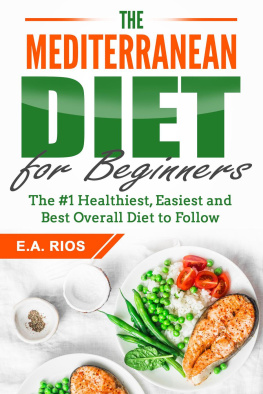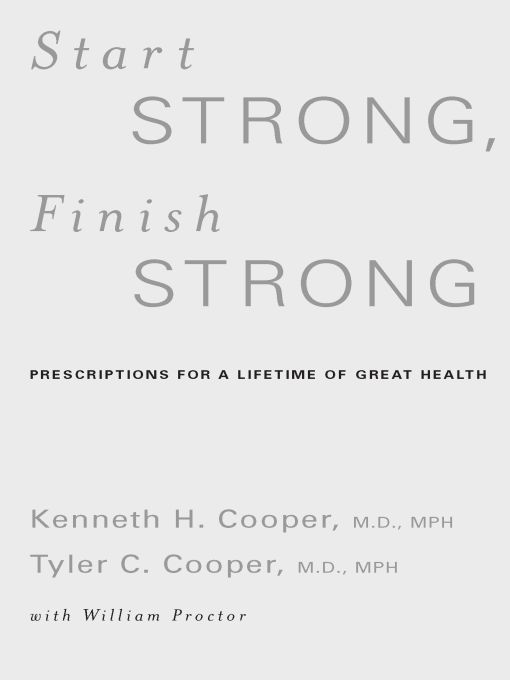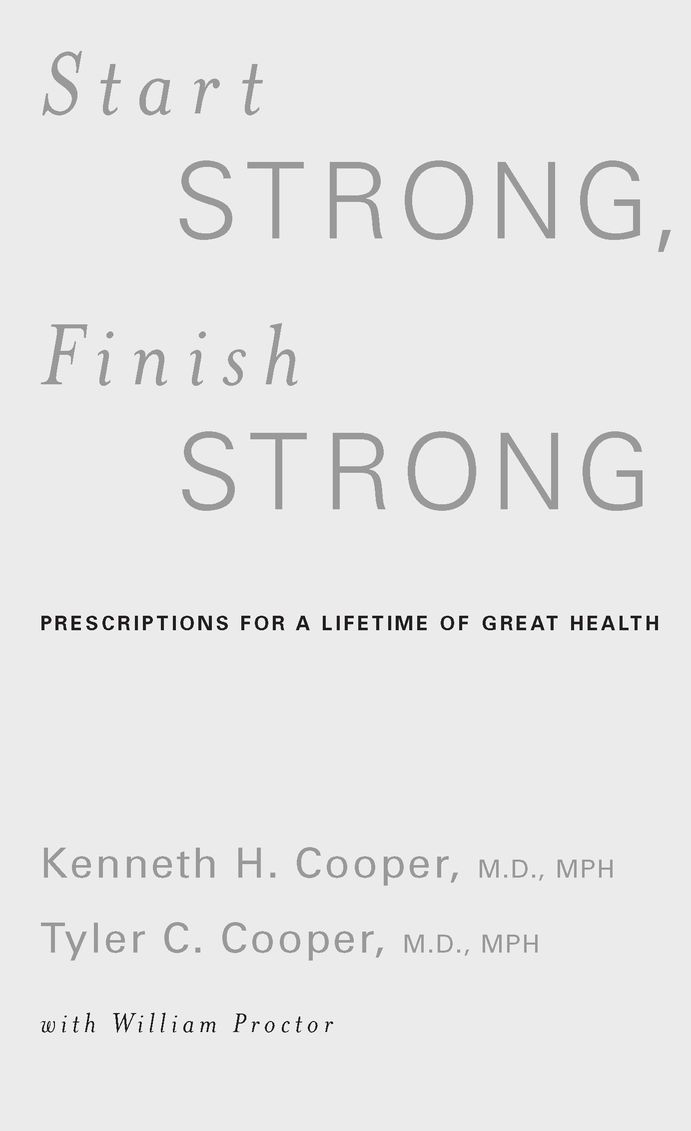Table of Contents
AVERY
a member of
Penguin Group (USA) Inc.
New York
To Clark Cooper
and Ridge and Tenley Estes,
with the hope that the information contained in this book will
help these young children live long, full, and healthy lives
ACKNOWLEDGMENTS
In producing this manuscript, we owe thanks to many people, including:
Our editor, Megan Newman, who has patiently and expertly guided our work to publication.
Our agent, David Hale Smith, whose advice, perseverance, and sensitivity to the publishing process have helped us shape the final product.
Cynthia Grantham, who, as usual, has oiled the administrative machinery necessary to help us communicate and collaborate effectively and efficiently.
Kathryn Miller, a registered dietitian at the Cooper Clinic, who has provided invaluable insights and information relating to the nutritional sections of the book.
Todd Witthorne, president of Cooper Concepts, as well as cohost and executive producer of our nationwide radio program, Healthy Living Radio from the Cooper Aerobics Center, who has made essential contributions to our chapter dealing with supplements.
Nina Radford, M.D., director of the cardiovascular medicine department at Cooper Clinic, who has provided important insights on the latest medical understanding about the efficacy of functional foods designed to lower levels of bad LDL cholesterol.
Jenna Adams, whose research abilities have enabled us to identify and organize the necessary scientific support for the manuscript.
David Atkinson, director of program development at Cooper Ventures, who has exercised his considerable creative skills in helping to prepare photo illustrations for exercises in the book.
Rebecca Behan, assistant editor on the Avery editorial staff, who has handled with aplomb many editorial and administrative matters related to the manuscript.
Pam Proctor, whose diligent editing was instrumental in helping to shape the initial draft of the manuscript.
Angie and Millie Cooper, whose advice and emotional support have kept us going through the months required to complete this effort.
Bill Proctor, whose writing and research skills have once again played an essential roleas they have with a dozen previous Cooper books.
Of course, many others have contributed to the final version of Start Strong, Finish Strong, including editors and staff at Avery and the Penguin Group; the staffs at the Cooper Clinic, Cooper Institute, Aerobics Center, and Wellness Center; and the staff at the DHS Literary Agency. They have given us a strong startone that we trust will culminate in a strong finish for all those who need to jump-start their health and fitness.
Kenneth H. Cooper, M.D., MPH
Tyler C. Cooper, M.D., MPH
PREFACE
Because one of us is thirtysomething and the other is in his seventies, we believe were in a unique position to offer a broad range of intergenerational health advice. Of course, like any other pair of strong-minded physicianswho also happen to be father and sonwe dont always agree on all the details of each problem and solution. But in the interests of full disclosure, when we do part company seriously on an issue, well let you know in no uncertain terms through a series of doc-to-doc dialogues and personalized boxes strategically positioned throughout the text.
Also, well occasionally speak to you in the first-person singular when we recount personal experiences one or the other of us has had in developing our respective medical understanding and philosophy. But the point of view in most of our narratives will be conveyed in the first-person plural, in part because most of the time, especially with regard to the latest scientific findings, we are in full agreement.
Many times, the names and identifying characteristics of patients we refer to have been altered to protect privacy and confidentiality. Other times, including those situations where the facts and names have been published elsewhere, we have used real names. In all cases, the basic framework of different illustrations and cases is factual.
INTRODUCTION
Dr. Ken Cooper probably saved my life.
Specifically, he and his colleagues at the Cooper Clinic have used their cutting-edge screening procedures to identify various red flags in my health profile, such as gradually rising cholesterol and an unexpected, and probably genetic, tendency to develop coronary artery plaque at a certain age. Strategic prescriptions and recommendations have corrected the problems and dramatically improved my risk profile.
But our friendship didnt get started in the examination room. I first met Ken in 1980 on a professional basis when I became the writer for his Aerobics Program for Total Well-Being, published in 1982. That collaboration, which helped me establish my own set of energy- and health-enhancing aerobic exercise habits, led to a twenty-six-year working relationship, during which weve produced more than a dozen books, including this current project, which breaks significant new ground with his son, Tyler, as coauthor.
Of course, its been exciting for me to see the Cooper books spreading around the globe, being translated into forty-one languages and Braille, with more than 30 million copies sold. But I feel especially fortunate that Ive been in a position to be cared for as his patient at the Cooper Clinic. In the process, my odds of maintaining high physical functionality as I age have increaseda benefit that he and Tyler call squaring off the curve of life (see Chapter 2).
Nor am I alone in reaping these benefits. In fact, Im just one of millions whose lives have been changed by the preventive medicine revolution sparked by Dr. Kenneth H. Cooper more than forty years ago.
So how exactly did this medical revolution get started?
It all began when Ken received his M.D. from the University of Oklahoma School of Medicine and then earned his master of public health degree (MPH) from the Harvard School of Public Health while an air force flight surgeon stationed in Texas. In the process, he received one of the earliest certifications from the American Board of Preventive Medicine.
The air force was Kens experimental laboratory for developing the aerobics concept. During his thirteen years of military service, he designed a series of unique fitness programs, including the twelve-minute and 1.5-mile fitness tests and the Aerobic Points System. The Aerobic Points System (see Chapter 8) assigns point values to various endurance exercises to rate their relative value as aerobic conditioning vehicles. In general, those who accumulate sufficient Aerobic Points on a regular weekly basis can expect to enjoy a much higher quality of life and a marked decrease in their risks for dying from any cause, including cardiovascular disease or cancer.
After Kens identification of the aerobic exercise concept, many others have built onand extendedhis work with such popular movements as aerobic dance and various cardio programs. Also, his historic aerobic fitness innovations and definitions are used by scientists as the standard to evaluate the impact of exercise on health and mortality. As a testament to the foundational quality of his research, Kens original fitness tests and other aerobic programs are also still employed by a variety of organizations, including the U.S. military, other governmental agencies, foreign military commands, FIFA (the international soccer association), many U.S. and foreign corporations, and more than a thousand universities and public schools.












